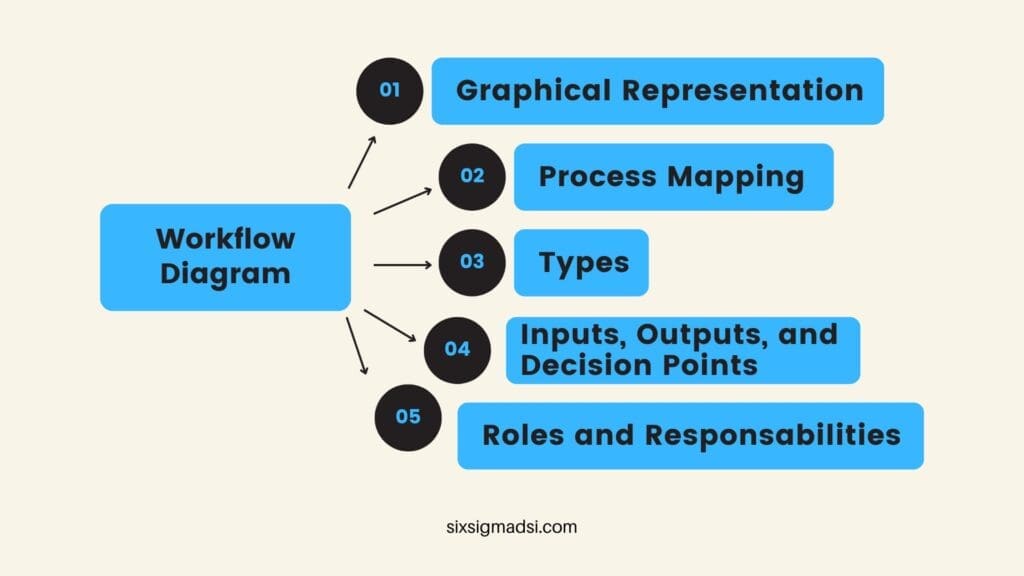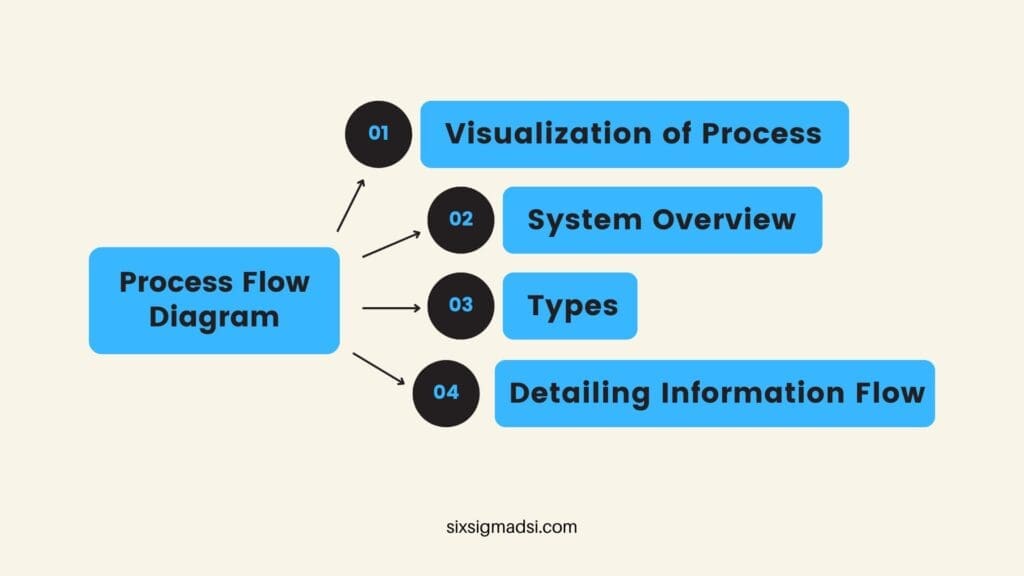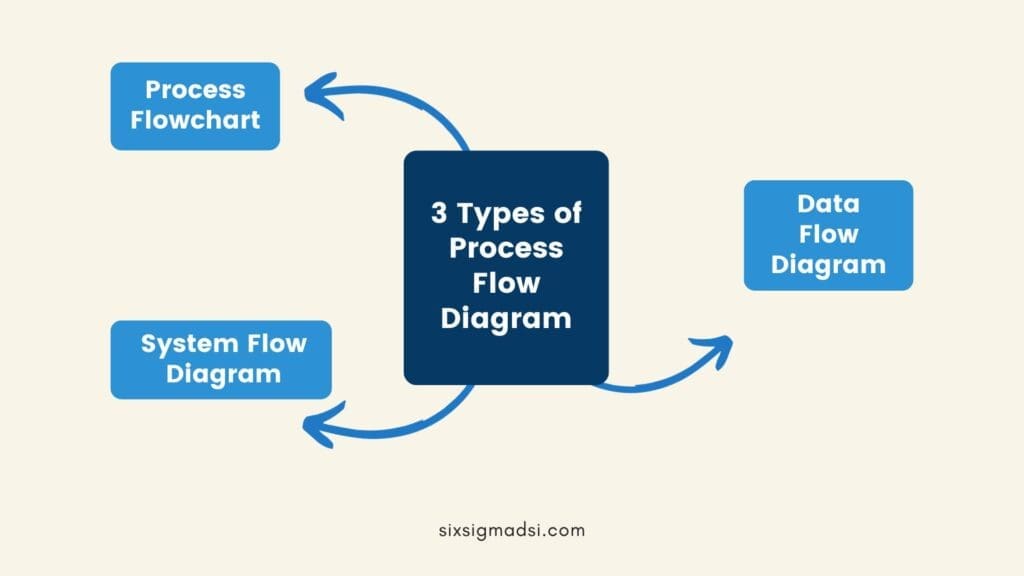Table of contents
- Workflow Diagram vs. Process Flow Diagram: Key Differences
- What is a Workflow Diagram?
- When to Use a Workflow Diagram
- The Components of a Workflow Diagram
- What is a Process Flow Diagram?
- When to Use a Process Flow Diagram
- The Components of a Process Flow Diagram
- What are The 3 Types of Process Flow Diagram?
- What are the Differences Between Workflow Diagrams and Process Flow Diagrams?
- Related Articles
Estimated reading time: 7 minutes
Workflow Diagram vs. Process Flow Diagram: Key Differences
In the fast-paced world of business and project management, understanding the nuances between various tools and techniques is crucial. Two commonly used terms are “workflow diagram” and “process flow diagram.” While these terms might seem interchangeable, they represent distinct concepts with unique purposes and applications. In this article, we will delve into the key differences between workflow diagrams and process flow diagrams, exploring their definitions, components, and when to use each. In the intricate landscape of business process optimization, understanding the distinctions between a workflow diagram and a process flow diagram is crucial. This article aims to provide a comprehensive insight into the principles of workflow process mapping, detail process maps, and the intricacies of process map design. With a meticulous examination of detailed process map design, we embark on a journey to elucidate the essential elements that demarcate these indispensable tools, empowering you with the knowledge to refine and streamline your organizational processes effectively.
What is a Workflow Diagram?

A workflow diagram is a visual representation of a process that outlines the steps and activities required to complete a specific task or achieve a particular outcome. It serves as a valuable tool for understanding the sequence of actions within a process and helps in identifying potential areas for improvement. Workflow diagrams come in various types, such as process flowcharts, swimlane diagrams, and SIPOC diagrams, each offering a different perspective on the process.
Key features of a workflow diagram include:
- Graphical Representation: Workflow diagrams use symbols, shapes, and lines to represent different components of a process. These graphical elements make it easier for people to visualize and understand the flow of activities.
- Process Mapping: Workflow diagrams involve mapping out the entire process, from the initiation to the completion of a task. Each step in the process is typically represented by a shape, and arrows indicate the direction of flow from one step to the next.
- Types of Workflow Diagrams: There are various types of workflow diagrams, each serving a specific purpose. Common types include process flowcharts, swimlane diagrams, SIPOC diagrams, and more. The choice of diagram depends on the complexity of the process and the level of detail required.
- Inputs, Outputs, and Decision Points: A well-constructed workflow diagram includes details about inputs (what is needed to start the process), transformations (actions performed on inputs), outputs (end results or products), and decision points (points where the flow of the process may change based on certain conditions).
- Roles and Responsibilities: Workflow diagrams often include information about the roles and responsibilities of individuals or departments involved in each step of the process. This helps clarify who is responsible for what within the workflow.
When to Use a Workflow Diagram
Workflow diagrams are particularly useful in situations where a detailed process map design is needed. Whether you are streamlining operations, implementing a new system, or analyzing current processes for optimization, a workflow diagram provides a comprehensive view of the entire process. The benefits of using workflow diagrams include enhanced clarity, improved communication, and a better understanding of dependencies between different steps.
The Components of a Workflow Diagram
A detailed process map design includes several essential components:
- Inputs: The initial data or materials required to initiate the process.
- Transformations: The specific actions or operations performed on inputs to produce outputs.
- Outputs: The end results or products generated by the process.
- Ovals: Represent the start and end points of the process.
- Rectangles: Indicate tasks or activities in the workflow.
- Diamonds: Signify decision points or branches in the process.
- Circles: Mark points where additional information or explanations may be included.
- Arrows: Illustrate the flow of the process from one step to the next.
What is a Process Flow Diagram?

A process flow diagram (PFD) is a visual representation that illustrates the sequence of steps and components involved in a process or system. Unlike workflow diagrams that focus on specific tasks, process flow diagrams provide a broader view, often detailing the overall structure of an organization’s operations. Process flow diagrams are versatile and can be used in various industries, from manufacturing and engineering to healthcare and project management.}
Key features of a Process Flow Diagram include:
- Visualization of Processes: Process Flow Diagrams use symbols and shapes to represent processes, activities, and components involved in a system. The graphical nature of these diagrams makes it easier to understand complex processes.
- System Overview: Unlike some other types of diagrams that focus on specific tasks or activities, Process Flow Diagrams offer a broader view of an entire system or process. They illustrate how different elements interact and contribute to the overall operation.
- Types of Components: Components in a Process Flow Diagram can include processes (represented by geometric shapes such as rectangles or circles), inputs and outputs, decision points, and arrows indicating the flow of information or materials between components.
- Detailing Information Flow: Process Flow Diagrams emphasize the flow of information or materials within a system. This makes them particularly useful for understanding how inputs are transformed into outputs and how data moves through various stages of a process.
When to Use a Process Flow Diagram
Process flow diagrams are ideal when you need to understand the bigger picture of an organizational goal or system. Use them when analyzing complex processes, designing new systems, or communicating the workflow to stakeholders. The benefits of employing process flow diagrams include improved clarity, enhanced collaboration, and a holistic understanding of the entire process.
The Components of a Process Flow Diagram
The components of a process flow diagram may vary based on the industry and specific requirements. However, common elements include:
- Processes: Represented by geometric shapes such as rectangles or circles.
- Inputs and Outputs: Clearly defined to understand the flow of information or materials.
- Decision Points: Indicated by diamonds, showing where the process could take different paths.
- Arrows: Connect components and illustrate the sequential flow of the process.
What are The 3 Types of Process Flow Diagram?

There are three main types of process flow diagrams, each serving a distinct purpose:
- Process Flowchart: Provides a comprehensive view of the entire process, including inputs, outputs, and decision points.
- Data Flow Diagram (DFD): Focuses on the flow of data within a system, highlighting how information moves between processes.
- System Flow Diagram: Illustrates the interaction between various components within a system, showcasing how they work together.
Each type of process flow diagram offers unique insights into different aspects of a process, allowing for a thorough analysis and understanding.
What are the Differences Between Workflow Diagrams and Process Flow Diagrams?
While workflow diagrams and process flow diagrams share similarities in their visual representation of processes, they differ in their focus and application. Workflow diagrams are task-oriented, emphasizing the steps required to complete a specific job. In contrast, process flow diagrams are goal-oriented, concentrating on the overall structure and flow of an entire process or system.
As you take a deeper look into your workflows and process flows, you will likely see opportunities for automation. Workflow diagrams, with their detailed task-oriented approach, can help identify specific areas where automation can streamline processes and improve efficiency. On the other hand, process flow diagrams provide a holistic view, aiding in the identification of bottlenecks and opportunities for optimization at the organizational level.
In conclusion, understanding the distinctions between workflow diagrams and process flow diagrams is essential for effective process management. Whether you are aiming to streamline day-to-day tasks or optimize the overall structure of your organization, choosing the right tool for the job is crucial. By incorporating workflow diagrams and process flow diagrams into your toolkit, you can enhance clarity, improve communication, and drive successful process improvements.



















